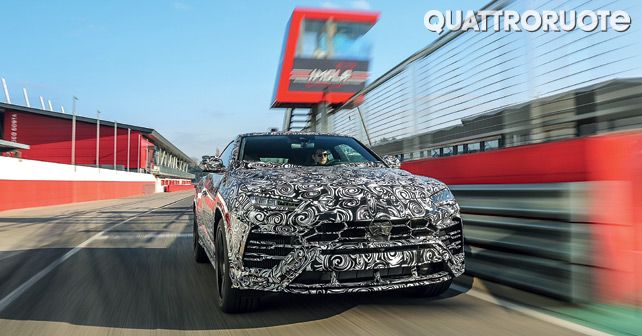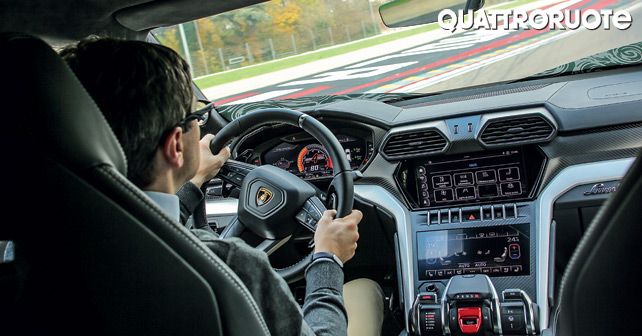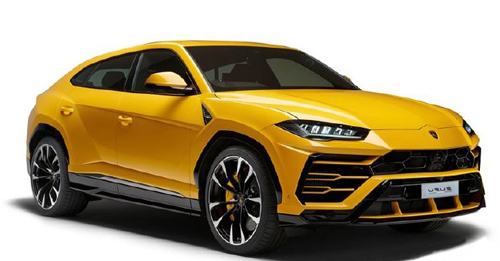We drove the Urus at a racetrack much before its official launch. As you can see, it wore full camouflage that time, but that wasn’t enough to hide its vast range of capabilities.
Lamborghini has dropped the veil on the Urus, and, in fact, it’s already been launched in India with an eye-watering price of `3 crores! But a few weeks before its global unveil, Lamborghini took us to a racetrack to get a sense of what their first SUV in a very long time feels like. Funnily enough, the location for the test was none other than Imola – a racetrack that’s named after Enzo Ferrari. While most of you would think this was done to take a dig at the folks at Maranello, it was more to do with the sense of confidentiality in this place. You see, Imola is very far away from the prying eyes of spy photographers. And, if you think about it, one look at this pre-production vehicle would have confirmed that it’s an Urus development mule – because there just aren’t that many SUVs at race circuits clipping kerbs and hitting apexes.
But this is a super SUV, and a Lamborghini at that – so everything had to be extreme. Let’s start with the way it looks. Even while standing still in the pit lane, the Urus oozes the kind of fury that Ferruccio Lamborghini used to consider a sort of trademark. It’s not discreet in any way, and neither does it look extraordinarily graceful. It has this brash and mean presence, and a sense of brutality – just like all other Lambos. Sure, it’s five meters long and has a lot of metal on its body, but despite that girth, it looks jaw-droppingly outlandish for a car – let alone an SUV.
Extremely driven
At a racetrack, it takes some time to register that you’re in a car as big as this. And sometimes that works against the product, because you tend to ask for too much. And, although the V8 motor has enough grunt, I wanted it to behave in a more mental and vigorous manner – more like a Lamborghini. But when you realise that you’re behind the wheel of a two-tonne SUV, your perspective changes completely. And the more I thought about it, the more I realised that I haven’t quite driven an SUV like this before!
The problem was that while I was adjusting the seat and the steering wheel, I started visualising the Urus to be a king-sized Huracán. But, to be honest, only a mad man would think like that. This is not a low-slung V10 Lambo. It’s a practical SUV – one that hits 100km/h in 3.6 seconds! Not only that, it weighs about 2,200kgs, the engine is mounted at the front and it rides a bit higher than your standard Huracan too. So, benchmarking it against its sibling would be a really silly thing to do. The right thing to do would be to compare its driving experience with a Maserati Levante or a Porsche Cayenne. And when you think on those lines, you’re forced to surrender to the fact that everything here happens at a superior level. The Urus covers ground rapidly in an inextricable mix of safety, fun and entertainment. There are different modes to choose from, and you’ll really be surprised by the car’s vast range of abilities. For example, let’s talk about its brakes. It has the biggest carbon ceramic front discs ever fitted to a production car, and as you’d expect, they bring this behemoth to a halt unlike any other SUV on the market. Next, let’s talk electronics. You put the car in Corsa mode and see how everything – the throttle, transmission, steering, suspension and traction control – changes from being perfectly safe to insanely exciting. The way it corners will have you fooled into believing that it has a wheelbase of 3 metres. And that’s largely because of its four-wheel steering and torque vectoring system.
Quick, but not loud
The Urus was at our disposal at a racetrack, and with each lap we discovered something new. Frankly, it’s shocking to find that it’s so agile and yet so stable at the same time. Surprisingly, the shift paddles are on the steering wheel and not on the steering column – for the first time on a Lamborghini. And if you think you’ll miss the snappy dual-clutch transmission, you’ll be awestruck with the eight-speeder of the Urus – it does the job of swapping gears briskly, albeit in a calm and comfortable manner. It’s not violent or jerky, even in the most hard-core setting. The thing that you do miss, however, are a few extra decibels from the exhaust. The noise from the V8 is nowhere as intoxicating or exciting as a V10 or V12. If not in all modes, at least in the Corsa setting, we were expecting it to be raw and loud – but it just wasn’t. Lamborghini technicians informed us that the noise levels were reduced because of new regulations. As for the ride quality, it felt supple and confident. That said, we don’t want to jump to a conclusion so soon – since we only went over a couple of kerbs on the racetrack.
Despite its mass, the Urus never gave the impression of any fatigue – not even its tyres.
The cabin, like all Lambos, is inspired by aviation. But this one includes the option of choosing drive modes that include Neve (snow), Terra (off-road) and Sabbia (sand).
- Lamborghini Urus
Engine: 3,996cc / V8 / Twin-turbo
Transmission: 8-Speed Automatic / All-Wheel Drive
Fuel: Petrol
Power: 641bhp @ 6,000rpm
Torque: 850Nm @ 2,250 – 4,500rpm
Acceleration: 0–100 km/h in 3.6 seconds
Price: Rs 3 crores (Ex-showroom)
© Riproduzione riservata





































Write your Comment